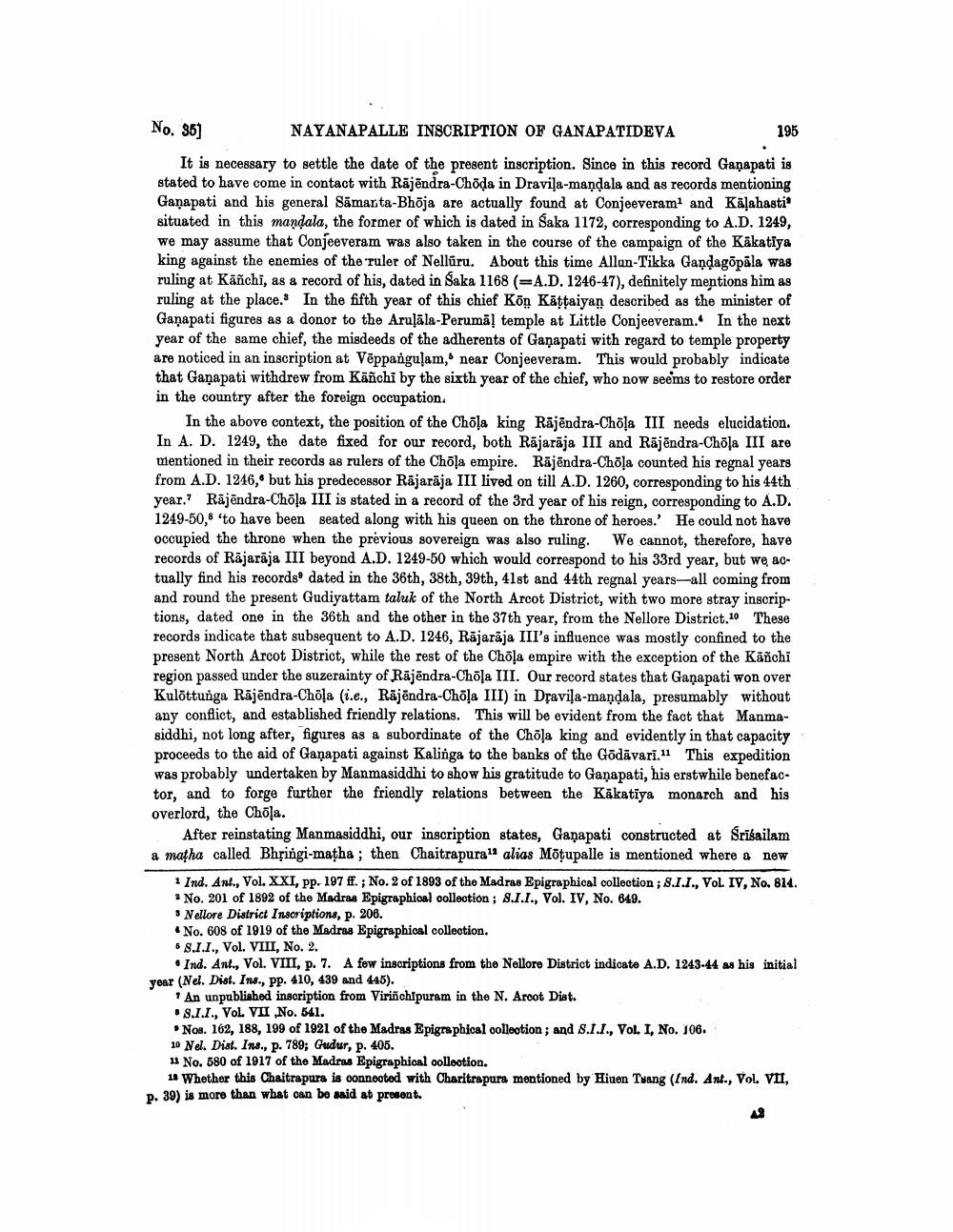________________
No. 36)
NAYANAPALLE INSCRIPTION OF GANAPATIDEVA
195
It is necessary to settle the date of the present inscription. Since in this record Ganapati is stated to have come in contact with Rājēndra-Choda in Dravila-mandala and as records mentioning Ganapati and his general Samarta-Bhõja are actually found at Conjeeveram and Kalahasti' situated in this mandala, the former of which is dated in Saka 1172, corresponding to A.D. 1249, we may assume that Conjeeveram was also taken in the course of the campaign of the Kakatiya king against the enemies of the ruler of Nellúru. About this time Allon-Tikka Gandagopala was ruling at Kāñchi, as a record of his, dated in Saka 1168 (A.D. 1246-47), definitely mentions him as ruling at the place. In the fifth year of this chief Kön Kättaiyan described as the minister of Ganapati figures as a donor to the Aruļāla-Perumāļ temple at Little Conjeeveram. In the next year of the same chief, the misdeeds of the adherents of Ganapati with regard to temple property are noticed in an inscription at Vēppanguļam, near Conjeeveram. This would probably indicate that Ganapati withdrew from Kāñchi by the sixth year of the chief, who now seems to restore order in the country after the foreign occupation.
In the above context, the position of the Chāļa king Rājēndra-Chola III needs elucidation. In A. D. 1249, the date fixed for our record, both Räjaräja III and Rājēndra-Chola III are mentioned in their records as rulers of the Chola empire. Rājēndra-Chöļa counted his regnal years from A.D. 1246, but his predecessor Rājarāja III lived on till A.D. 1260, corresponding to his 44th year.? Räjëndra-Chēļa III is stated in a record of the 3rd year of his reign, corresponding to A.D. 1249-50,8 'to have been seated along with his queen on the throne of heroes.' He could not have occupied the throne when the previous sovereign was also ruling. We cannot, therefore, have records of Rajarāja III beyond A.D. 1249-50 which would correspond to his 33rd year, but we actually find his records dated in the 36th, 38th, 39th, 41st and 44th regnal years-all coming from and round the present Gudiyattam taluk of the North Arcot District, with two more stray inscriptions, dated one in the 36th and the other in the 37th year, from the Nellore District.10 These records indicate that subsequent to A.D. 1246, Rājarāja III's influence was mostly confined to the present North Arcot District, while the rest of the Chola empire with the exception of the Kāñchi region passed under the suzerainty of Rājēndra-Chōļa III. Our record states that Ganapati won over Kulottunga Rājēndra-Chöļa (i.e., Rājēndra-Chēļa III) in Dļaviļa-maņdala, presumably without any conflict, and established friendly relations. This will be evident from the fact that Manmasiddhi, not long after, figures as a subordinate of the Chola king and evidently in that capacity proceeds to the aid of Ganapati against Kalinga to the banks of the Gödāvari." This expedition was probably undertaken by Manmasiddhi to show his gratitude to Ganapati, his erstwhile benefactor, and to forge further the friendly relations between the Kakatiya monarch and his overlord, the Chola.
After reinstating Manmasiddhi, our inscription states, Ganapati constructed at Srisailam a matha called Bhringi-matha; then Chaitrapura" alias Mötupalle is mentioned where a new
1 Ind. Ant., Vol. XXI, pp. 197 ff.; No. 2 of 1893 of the Madras Epigraphical collection ; 8.1.1., Vol. IV, No. 814. * No. 201 of 1892 of the Madras Epigraphical collection; 8.I.I., Vol. IV, No. 149. * Nellore District Inscriptions, p. 206.
No. 608 of 1919 of the Madras Epigraphical collection. 5 8.1.1., Vol. VIII, No. 2.
• Ind. Ant., Vol. VIII, p. 7. A fow inscriptions from the Nellore District indicato A.D. 1243-44 as his initial year (Ne. Dist. In., pp. 410, 439 and 445).
* An unpublished inscription from Virinchipuram in the N. Aroot Dist. • 8.1.1., VOL VII No. 541.
Nos. 162, 188, 199 of 1921 of the Madras Epigraphical collection, and 8.1.1., Vol. I, No. 106. 10 Nel. Dist. Ins., p. 789; Gudur, p. 405. 1 No. 680 of 1917 of the Madras Epigraphical colleotion.
11 Whether this Chaitrapura is connected with Charitrapura mentioned by Hiuen Twang (Ind. Ant., Vol. VII, p. 39) is more than what can be said at present.




